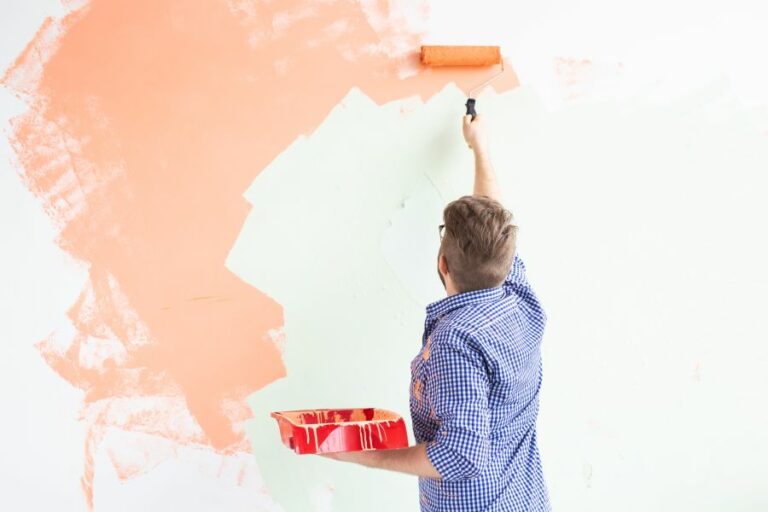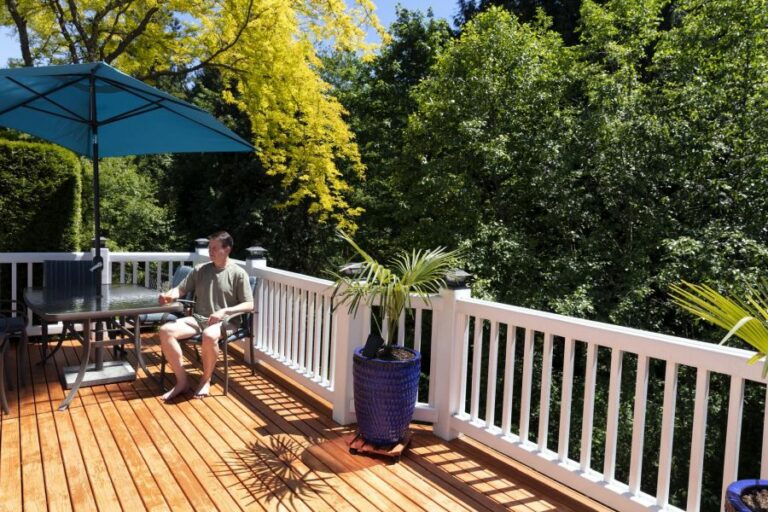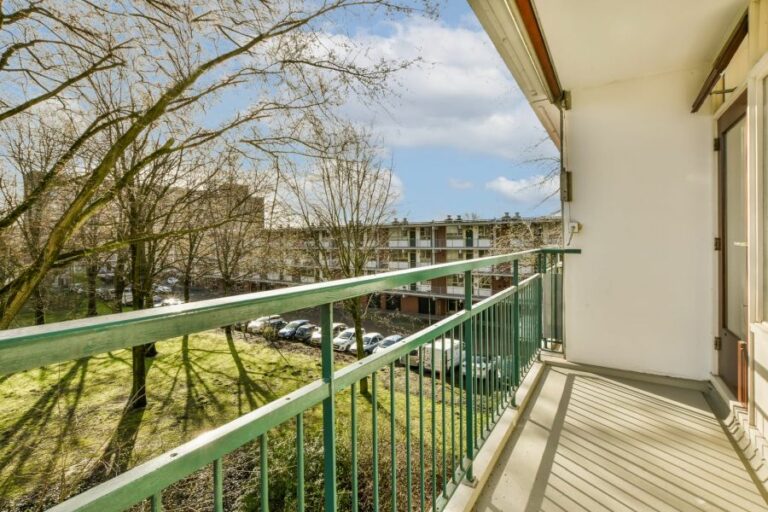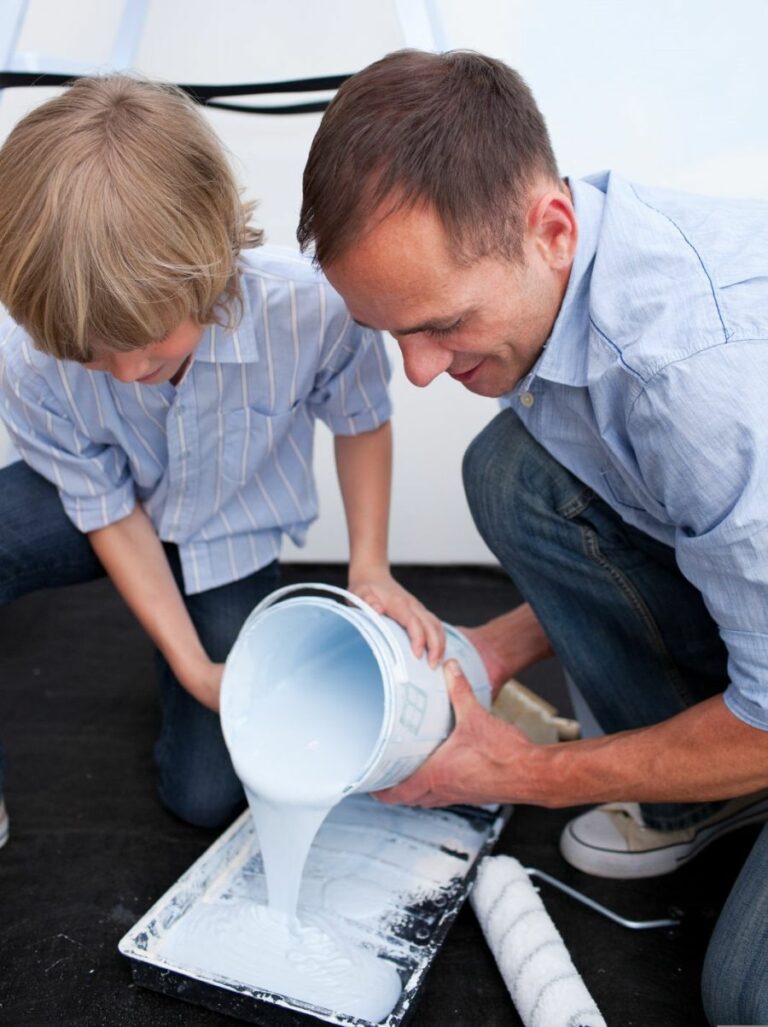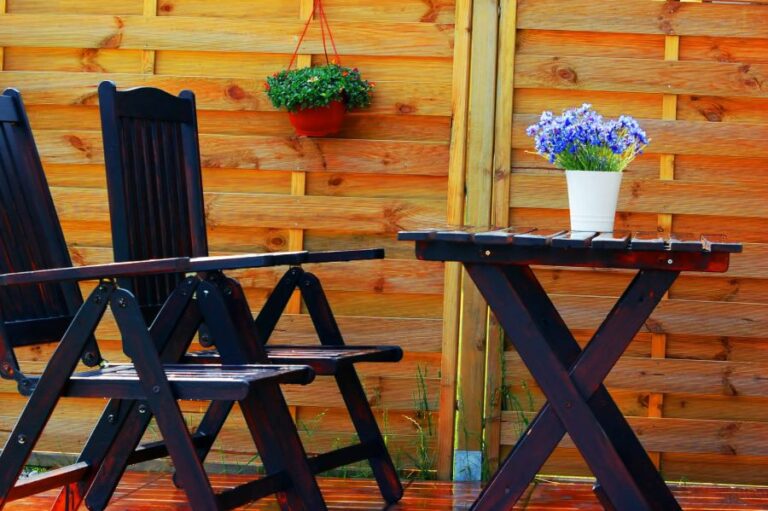Best Outdoor Paint For Stucco, 25 Things You Should Know
Finding the best outdoor paint for stucco can be quite challenging, given the number of options available in the market. But worry not because we’re here to help you make an informed decision. We have researched and tested various paint brands and types specifically formulated for stucco surfaces, and we’re confident that we can guide you toward the perfect choice for your project.
Best outdoor paint for stucco:
The best outdoor paint for stucco depends on the desired characteristics, with two top options being acrylic and elastomeric paints. Acrylic paint, such as Sherwin-Williams SuperPaint Exterior Acrylic Latex, is easy to apply, breathable, and relatively inexpensive. Elastomeric paint, like BEHR Premium Elastomeric Masonry, Stucco & Brick Paint, offers excellent durability, flexibility, and UV protection but can be more expensive and challenging to apply.

Ready to refresh your house’s exterior? Discover the best outdoor paint options for stucco surfaces, their key features, and application tips to ensure lasting curb appeal. Read on to find the perfect paint choice for your home renovation project.
Contents
- 1 Top-Rated Exterior Stucco Paint for Optimal Results
- 2 What is the most suitable paint choice for exterior stucco surfaces?
- 3 Is Applying Paint on Stucco More Effective Using a Sprayer or a Roller?
- 4 What is the appropriate choice between satin or flat paint for exterior stucco surfaces?
- 5 Is Priming Stucco Necessary Prior to Applying Paint?
- 6 What is the Most Effective Waterproofing Paint for Stucco Surfaces?
- 7 Which is Superior for Stucco Surfaces: Acrylic or Elastomeric Paint?
Top-Rated Exterior Stucco Paint for Optimal Results
Stucco is a popular exterior finish because of its durability, versatility, and attractive appearance. However, choosing the right paint for stucco is essential to ensure lasting color and protection.
• Choosing the Right Paint Type for Stucco
When it comes to painting stucco, there are two primary paint types to consider: acrylic and elastomeric. Each type has its advantages and drawbacks, making it essential to understand their differences before making a decision.
– Acrylic Paint
Acrylic paint is a water-based paint that is easy to apply and clean up. It has excellent adhesion properties and is suitable for use on various surfaces, including stucco.
Acrylic paint is also breathable, allowing moisture to evaporate from the stucco surface and preventing paint failure due to trapped moisture.
Pros:
- Easy to apply
- Good coverage
- Quick-drying
- Breathable
- Relatively inexpensive
Cons:
- May require multiple coats
- Not as flexible as elastomeric paint
Recommended product: Sherwin-Williams SuperPaint Exterior Acrylic Latex
– Elastomeric Paint
Elastomeric paint is a high-performance, rubber-like coating that is specifically designed for masonry surfaces such as stucco. It forms a thick, flexible layer that helps bridge small cracks and prevents water infiltration.
Moreover, elastomeric paint provides superior protection against damaging UV rays and weathering.
Pros:
- Excellent durability
- Highly flexible and crack-resistant
- Waterproof
- Superior protection against UV rays
Cons:
- More expensive than acrylic paint
- Can be challenging to apply
- May require special equipment (such as an airless sprayer) for proper application
Recommended product: BEHR Premium Elastomeric Masonry, Stucco & Brick Paint
• Preparing Stucco for Painting
A crucial step in achieving a long-lasting paint job is properly preparing the stucco surface. In particular, it is vital to ensure that the stucco is clean, dry, and free of any loose or peeling paint.
– Cleaning the Stucco Surface
Before painting, clean the stucco surface thoroughly to remove dirt, dust, and mold or mildew. Using a pressure washer with a low-pressure tip is an efficient way to clean large stucco surfaces. Alternatively, a garden hose with a spray nozzle and a soft-bristle brush can be used for smaller or more delicate areas.
– Repairing Stucco Damage
Before painting, inspect the stucco surface for any visible damage or cracks. Small cracks can be filled with a high-quality, paintable acrylic caulk. For more extensive damage, consider hiring a professional stucco repair contractor to ensure a flawless finish.
– Priming Stucco
Applying a high-quality masonry primer is essential for optimal paint adhesion and durability. Furthermore, a primer helps to seal the stucco surface, prevent efflorescence, and ensure even paint coverage. Some recommended primers for stucco include:
- Loxon Concrete & Masonry Primer/Sealer
- BEHR Premium Concrete & Masonry Bonding Primer
• Painting Stucco: Tips for Success
Once the stucco surface has been properly prepared and primed, it is time to paint. Here are some tips for a successful stucco paint job:
- Choose the right tools: Use a high-quality paint roller with a 1″ to 1-1/4″ nap for rough stucco surfaces. For elastomeric paint, it’s recommended to use an airless paint sprayer with a .015 to .019 tip size.
- Paint in the right weather conditions: Optimal painting conditions are typically between 50F and 90F and during low humidity. Avoid painting in direct sunlight or high winds, as this can negatively affect the paint’s performance.
- Apply multiple coats: To achieve a uniform, durable finish, it’s essential to apply at least two coats of paint. Allow each coat to dry thoroughly before applying the next.
- Proper paint maintenance: Regularly inspect the stucco surface for any signs of damage and promptly address any issues. Clean and maintain the paint job by washing the surface with a gentle detergent and water every few years.
• Conclusion
Choosing the best outdoor paint for stucco is essential for creating a long-lasting, attractive finish. Acrylic and elastomeric paints each offer unique benefits, making them the top contenders for stucco finishes.
Proper surface preparation and painting techniques, as well as regular maintenance, will ensure that your stucco paint job remains in excellent condition for years to come.
For more information on stucco and paint selection, visit Portland Cement Association’s resources on stucco finishes and coating systems.
Brand | Product Name | Features |
|---|---|---|
Behr | BEHR Masonry, Stucco & Brick Paint | Flat finish, highly durable, alkali-resistant, easy to apply |
Sherwin-Williams | Loxon XP Masonry Coating | High-performance, waterproofing, excellent adhesion, alkali resistance |
PPG Paints | PERMA-CRETE PITT-FLEX Elastomeric Coating | Flexible, excellent hiding, algae & mildew resistant, alkali resistant |
Valspar | Valspar Elastomeric Exterior Masonry & Stucco Paint | 100% acrylic, weather resistant, UV protection, elastomeric |
Rust-Oleum | Rust-Oleum Zinsser Perma-White Exterior | Satin finish, water-based, weather resistant, mold & mildew resistance |
What is the most suitable paint choice for exterior stucco surfaces?
Stucco, a versatile and attractive finish for exterior walls, has been a popular choice for centuries due to its durability and low maintenance requirements. Choosing the right paint for stucco is crucial in preserving its appearance and longevity.
• Why the Right Paint Matters for Stucco
Stucco is a porous material, which allows it to expand and contract with temperature changes. Picking the wrong type of paint can result in bubbling, peeling, or cracking, which can ultimately lead to water penetration, mold growth, and costly repairs.
Therefore, it is essential to select the right paint that provides adequate waterproofing and protection from harsh weather conditions.
• Acrylic Paints: The Top Choice for Exterior Stucco
Acrylic paints are water-based and have great adhesion properties, making them the ideal choice for stucco exteriors. They form a flexible film that expands and contracts with the stucco, preventing cracks and bubbles.
Additionally, acrylic paints are highly resistant to UV rays, which ensures the color remains vibrant over time.
– Advantages of Acrylic Paint for Stucco
- Adhesion: Acrylic paints adhere exceptionally well to stucco surfaces, minimizing the risk of peeling or chipping.
- Flexibility: They provide a flexible film that allows the stucco to breathe and move with temperature changes, preventing cracks and blistering.
- UV Resistance: Acrylic paints are highly resistant to the sun’s harsh UV rays, ensuring that the color remains vibrant and doesn’t fade over time.
- Water Resistance: These paints provide a waterproof barrier, protecting the stucco from water penetration, mold, and mildew.
Based on my experience, I highly recommend using 100% acrylic paint for exterior stucco applications. This type of paint provides the highest level of performance and durability, ensuring your stucco will look great for years to come.
• Elastomeric Coatings: Extra Protection for Stucco
Elastomeric coatings are a specialized type of acrylic paint that offers even greater flexibility and waterproofing than standard acrylics. They form a thick, rubber-like membrane that adheres to the stucco, offering superior protection against water penetration and weather-related damage.
– When to Consider Elastomeric Coatings
- Cracked or Damaged Stucco: If your stucco has developed cracks or other signs of damage, elastomeric coatings can help bridge these gaps and provide extra protection.
- High Humidity or Rainfall: Homes in regions with high humidity or heavy rainfall can benefit from the added waterproofing provided by elastomeric coatings.
- Extreme Temperature Fluctuations: If you live in an area with significant temperature changes, elastomeric coatings offer enhanced flexibility to prevent cracks and damage caused by thermal expansion and contraction.
While elastomeric coatings can be more expensive than regular acrylic paint, investing in this type of paint can save you money in the long run by preventing costly repairs and stucco replacement.
• Choosing the Right Sheen for Your Stucco
The sheen of paint refers to its degree of shininess or reflectivity. For stucco exteriors, the following sheen options are available:
- Flat: This sheen is non-reflective and offers a minimal light reflection. Due to its ability to hide surface imperfections, a flat sheen is a popular choice for stucco and other textured surfaces.
- Satin: Satin sheen provides a subtle, low-level gloss and offers better durability and washability than flat sheen.
- Semi-gloss: This sheen has a higher level of reflectivity, providing increased durability and resistance to stains and mildew. However, a semi-gloss sheen can highlight imperfections in the stucco surface.
Based on my experience, I recommend using a flat or satin sheen for exterior stucco surfaces. These sheens provide a balance between durability and aesthetics, ensuring your stucco looks great while remaining protected from the elements.
• Preparing Your Stucco for Painting
Before applying paint to your stucco exterior, ensure that the surface is clean and free of debris. Use a pressure washer to remove any dirt or mildew on the stucco.
You may also need to patch and repair any cracks, followed by a thorough drying period. The use of a high-quality primer can further enhance the adhesion and overall performance of the paint.
• Conclusion
Selecting the right paint for your exterior stucco plays a critical role in preserving its appearance and longevity. Acrylic paints, particularly 100% acrylic paint, are the top choice due to their outstanding adhesion, flexibility, and UV resistance.
In certain situations, elastomeric coatings offer extra protection for damaged, high-humidity, or extreme temperature environments. Finally, choose a flat or satin sheen for a balance between durability and aesthetics.
Preparing the stucco surface properly and using high-quality paint will ensure your home’s exterior remains beautiful and well-protected for many years to come.
Is Applying Paint on Stucco More Effective Using a Sprayer or a Roller?
When painting the exterior of a stucco home, homeowners are faced with the choice between spray painting and roll painting.
Each method has its own unique set of advantages and drawbacks, depending on various factors such as the condition of the stucco, the desired finish, and the level of skill required to complete the job.
• Spray Painting Stucco: Speed and Efficiency
One of the primary advantages of spray painting stucco is the speed at which it can be accomplished. Using a high-quality paint sprayer allows for quick application of paint, which can be particularly beneficial for large exterior surfaces.
This increased speed can save significant amounts of time, especially when compared to the slower process of roll painting.
– Smooth, Consistent Finish
Another advantage of spray painting stucco is the ability to achieve a smooth, even finish without any brush or roller marks. This can result in a more professional-looking paint job, as well as a more durable and longer-lasting finish.
To achieve this finish, it is essential to use a paint sprayer with the appropriate settings and nozzle size for the specific type of paint and stucco surface being painted.
– Suitable for Detailed and Textured Surfaces
Spray painting is also a suitable choice for stucco surfaces with intricate details or heavy texture. Due to the nature of spray application, paint can easily reach into small crevices and cover textured surfaces more evenly than a roller.
As a result, spray painting is often recommended for stucco exteriors with unique architectural features or a highly textured finish.
– Drawbacks of Spray Painting Stucco
Despite its advantages, spray painting stucco also has some potential drawbacks. One notable disadvantage is the increased possibility of overspray, which can result in paint coverage on unwanted areas, such as windows, doors, or landscaping.
To minimize the risk of overspray, it is essential to carefully mask off adjacent surfaces and use drop cloths to protect landscaping.
Additionally, spray painting can require a higher level of skill and experience to achieve the best results. Proper technique, equipment maintenance, and knowledge of appropriate spray settings are essential for a successful spray paint job.
Furthermore, the initial investment in a high-quality paint sprayer can be costly for homeowners who do not already own one.
• Roll Painting Stucco: A More Controlled Approach
Roll painting stucco offers a different set of advantages and disadvantages compared to spray painting. One of the key benefits of roll painting is the increased control it offers during application.
– Less Risk of Overspray
Roll painting stucco eliminates the risk of overspray, allowing homeowners to paint with more precision and control. This can be especially beneficial for those with limited painting experience or those painting stucco exteriors with numerous windows, doors, or other areas that require careful paint application.
– Material Savings
Roll painting often results in less wasted paint, as there is less risk of overspray or paint drifting onto unnecessary surfaces. This can lead to cost savings, as less paint may be required to complete the job.
– Drawbacks of Roll Painting Stucco
One major drawback of roll painting stucco is the increased time and effort required, especially in comparison to spray paint. Due to the nature of stucco surfaces, multiple coats of paint may be required to achieve proper coverage and a uniform finish.
The process of applying paint with a roller can be time-consuming and labor-intensive, particularly for large exterior surfaces.
Additionally, roll painting may not be the best choice for stucco surfaces with heavy texture or intricate details, as achieving even coverage can be more challenging with a roller.
• Making the Right Choice: Spray or Roll Paint on Stucco
Based on the information provided, the decision to spray or roll paint on stucco will depend on multiple factors, such as the size and complexity of the surface, the desired finish, and the level of skill and experience of the individual applying the paint.
For large, textured stucco surfaces, I recommend spray painting to save time and achieve a more even, professional finish. However, for smaller projects or stucco exteriors with numerous windows and doors, roll painting may be a more cost-effective and controlled option.
Regardless of the method chosen, it is crucial to spend time on proper surface preparation, mask off adjacent surfaces, and use high-quality paint and equipment to achieve the best, long-lasting results.
What is the appropriate choice between satin or flat paint for exterior stucco surfaces?
A well-painted exterior stucco surface not only adds to the aesthetic appeal of your home but also protects it from harsh weather conditions, sunlight, and other environmental factors. Making the right choice of paint type is crucial for long-lasting results and easy maintenance.
• Understanding Satin and Flat Paints
– Satin Paints
Satin paint, also known as eggshell or low-luster paint, is a type of acrylic-latex paint that provides a soft sheen and subtle gloss.
It is more durable than flat paint and offers better resistance to moisture and stains, making it an ideal choice for any surface where there may be slight weathering or exposure to moisture, such as exterior walls or trim.
- Pros: Good durability, moisture and stain resistance, easy to clean, less color fading, more forgiving with surface imperfections than the glossier paints.
- Cons: May highlight imperfections, requires careful and even application to avoid streaking or uneven sheen, slightly more expensive than flat paint.
– Flat Paints
Flat paint (also known as matte paint) has no sheen and is a non-reflective paint finish. It is commonly used for exterior surfaces because it provides an even and uniform color, minimizes surface imperfections, and easily hides previous paint layers.
- Pros: Hides surface imperfections, provides even color, low price.
- Cons: Low durability, harder to clean, more prone to color fading, less resistant to moisture and weathering.
• Factors to Consider When Choosing Paint for Exterior Stucco
– Climate
The climate and weather conditions of your location are key factors to consider when choosing between satin and flat paint.
In areas with high levels of rainfall or humidity, satin paint is generally recommended due to its moisture resistance and easy cleanability. For drier climates with less moisture, flat paint may suffice.
– Durability and Maintenance
Satin paint offers better longevity compared to flat paint, as it is more resistant to color fading, weathering, and moisture. It is also easier to clean, making it a more practical choice for homeowners seeking low maintenance.
Flat paint, on the other hand, is less durable and might require more frequent touch-ups and repainting.
– Aesthetics
The choice between satin and flat paint largely depends on the desired appearance of your home. Satin paint offers a slight sheen and a richer appearance that enhances the architectural details and design elements of your exterior stucco.
Flat paint provides a matte, non-reflective finish, which can be more forgiving of surface imperfections.
– Cost
Although satin paint generally costs more than a flat paint, the long-term savings in durability, maintenance, and appearance may offset the initial price difference. It is important to weigh the upfront cost versus the long-term benefits when selecting paint for your exterior stucco project.
• Expert Recommendations
Based on my experience with exterior stucco painting, I would recommend satin paint for homeowners seeking a balance between aesthetics, durability, and maintenance.
Satin paint offers a soft sheen that highlights the texture and architectural details of stucco while providing adequate protection against moisture and weathering.
Additionally, it is easier to clean and maintain compared to flat paint, resulting in a longer-lasting and more attractive finish.
Flat paint, while cost-effective and capable of hiding surface imperfections, tends to have a shorter lifespan and lower resistance to moisture and weathering. Therefore, I would suggest using flat paint for drier climates or when the primary goal is to minimize surface imperfections.
• Final Thoughts
Choosing the right paint finish for exterior stucco involves considering factors like climate, durability, maintenance, aesthetics, and cost.
While both satin and flat paints have their pros and cons, satin is generally the recommended option for its balance of sheen, durability, and resistance to moisture and stains.
Is Priming Stucco Necessary Prior to Applying Paint?
• Understanding Stucco
Stucco is a durable and long-lasting exterior wall covering made from a mixture of cement, lime, and sand. It can be applied in several layers to create a textured finish and is often used on residential and commercial buildings for its aesthetic appeal and weather-resistant properties.
Over time, stucco may begin to show signs of wear or discoloration, prompting the need for a fresh coat of paint.
• The Importance of Priming Stucco
While it may be tempting to simply apply a new coat of paint directly onto stucco, this can result in poor adhesion and a number of issues down the line. Priming stucco before painting provides several benefits that make the extra investment of time and resources worthwhile:
– Enhanced Paint Adhesion
Priming creates a uniform surface for paint to adhere to, ensuring a strong bond between the stucco and the new layer of paint. This reduces the risk of paint peeling or flaking off over time, ultimately leading to a longer-lasting finish.
– Improved Paint Coverage
A quality primer can help to even out the color and texture of the stucco, resulting in a more consistent final paint job. This can be particularly beneficial if the stucco has become discolored or stained in certain areas.
– Better Moisture Resistance
Stucco is naturally porous, meaning it can absorb moisture and potentially lead to the growth of mold or mildew. Priming stucco creates a barrier that helps to prevent water from seeping through.
– Extended Paint Life
By providing a proper base for paint, priming stucco can help to prolong the lifespan of the paint job itself, reducing the need for frequent maintenance or repainting.
• Choosing the Right Primer for Stucco
There are several types of primers available on the market, and choosing the right one for your stucco surface is crucial. I recommend considering the following factors when selecting a primer:
– Acrylic vs. Oil-Based Primers
Acrylic primers are water-based products that are generally easier to work with and easier to clean up. They provide excellent adhesion to stucco and dry relatively quickly. Oil-based primers, on the other hand, can take longer to dry but offer unparalleled durability and stain-blocking capabilities.
For most stucco surfaces, an acrylic primer is sufficient, but if you’re dealing with heavy stains or a particularly challenging surface, you may want to consider an oil-based primer.
– Stain-Blocking Properties
If your stucco has visible stains or discoloration, choose a primer with built-in stain-blocking properties to help create a uniform and clean surface for painting. Look for a primer specifically labeled as “stain-blocking” or “high-hiding” to ensure it has the necessary capabilities.
– Vapor Permeability
Since stucco can absorb moisture, I recommend using a primer with a high degree of vapor permeability. This will allow moisture to escape from the stucco without compromising the integrity of the paint job. A primer’s vapor permeability is usually indicated on its product label or technical data sheet.
When in doubt, consult an expert at your local paint or home improvement store, as they can provide guidance on selecting the most suitable primer for your stucco surface.
In addition, consult the US Department of Energy’s guide on insulation to learn more about the role and importance of vapor permeability in various building materials.
• How to Prime Stucco
Proper application of primer is crucial in achieving a successful paint job. Follow these steps to ensure your stucco surface is properly primed:
- Clean the Surface: Remove any dust, dirt, or debris from the stucco using a pressure washer, soft-bristle brush, or hose. Allow the surface to dry completely before proceeding.
- Repair Any Damage: Inspect the stucco for any cracks or damaged areas and repair them with a suitable patching compound. Allow the repairs to dry and cure according to the manufacturer’s instructions.
- Apply the Primer: Using a high-quality roller or brush, apply the primer evenly and consistently across the entire stucco surface. Follow the manufacturer’s directions for coverage and drying times, and ensure the primer is applied at the recommended thickness.
- Allow the Primer to Dry: Before applying a new coat of paint, allow the primer to dry according to the product label, typically between 24 to 48 hours.
By taking the time to prime your stucco surface properly, you’re setting the stage for a successful and durable paint job that will stand the test of time.
What is the Most Effective Waterproofing Paint for Stucco Surfaces?
Stucco, a plaster-like building material made from a mixture of cement, sand, and water, is commonly used on exterior walls. Stucco provides a durable and attractive finish, but it is also susceptible to moisture damage.
Waterproofing paint is essential to protect your stucco siding from water infiltration, which can lead to costly repairs.
• Choosing the Right Waterproofing Paint for Stucco
When selecting the best waterproofing paint for stucco, it is crucial to consider the following factors:
– Waterproofing Technology
There are two primary types of waterproofing technologies in paint: film-forming and penetrating.
- Film-forming waterproofing paints create a barrier on the stucco surface, preventing water penetration. These paints typically have a higher level of water resistance, but they can also trap moisture inside the stucco, leading to potential damage.
- Penetrating waterproofing paints are absorbed into the stucco, filling pores and small cracks while allowing the stucco to breathe. This maintains the natural moisture balance within the wall, which helps prevent damage from trapped moisture.
For stucco, penetrating waterproofing paints are generally the better choice due to their moisture balance and breathability. However, in high-moisture environments, a high-quality film-forming paint might be necessary for increased water resistance.
– Breathability
The breathability of waterproofing paint is crucial for maintaining the integrity of the stucco. Breathable paints permit water vapor to escape, reducing the risk of moisture buildup within the stucco.
When choosing a waterproofing paint, look for product information indicating breathability or a high permeability rating.
– Additional Protective Features
In addition to waterproofing, it is beneficial to choose a paint that offers extra protection, such as:
- UV Resistance: Prolonged exposure to ultraviolet (UV) rays can degrade stucco, making it more susceptible to moisture damage. Choose a paint that provides UV resistance to extend the life of your stucco siding.
- Mildew Resistance: Stucco can be prone to mildew growth if not properly protected. Look for a paint with mildew-resistant properties to prevent mildew growth and maintain a clean, attractive appearance.
- Dirt Resistance: Dirt and grime can accumulate on stucco surfaces over time. A dirt-resistant paint makes cleaning easier and helps maintain the appearance of the stucco.
• Recommended Waterproofing Paints for Stucco
Here are some top-rated waterproofing paints suitable for stucco surfaces:
- Drylok Extreme Masonry Waterproofer: This water-based, film-forming paint provides excellent water resistance and is designed for use on various masonry surfaces, including stucco. Drylok Extreme has a breathable film, UV resistance, and mold and mildew resistance, making it an all-around excellent choice for stucco protection.
- ElastoMeric Waterproof Coating by QUIKRETE: This flexible, film-forming paint is specifically formulated for stucco and masonry surfaces. It has excellent waterproofing capabilities and is both dirt and mildew resistant.
- Siloxa-Tek 8500 Concrete Sealer by Ghostshield: This penetrating, water-based sealer is suitable for use on stucco and provides long-lasting waterproofing protection. It is also UV resistant and helps to reduce efflorescence and freeze-thaw damage.
• Tips for Applying Waterproofing Paint to Stucco
To ensure the best results when applying waterproofing paint to your stucco, follow these tips:
- Surface Preparation: Thoroughly clean the stucco surface, removing dirt, debris, and peeling paint. Repair any cracks or damages before applying the waterproofing paint.
- Primer Application: Before applying waterproofing paint, use a high-quality masonry primer to ensure proper paint adhesion and further protect the stucco.
- Multiple Coats: Apply at least two coats of waterproofing paint for maximum protection. Allow each coat to dry completely before applying the next one.
- Weather Conditions: Opt for mild, dry weather conditions during paint application, avoiding extremely hot, cold, or humid days. This ensures proper drying and curing of the paint.
By considering factors such as waterproofing technology, breathability, and additional protective features, you can choose the best waterproofing paint for your stucco siding.
By using products like Drylok Extreme, ElastoMeric Waterproof Coating, or Ghostshield’s Siloxa-Tek 8500 and following proper application techniques, you will extend the life and maintain the integrity of your stucco exterior.
For more information about stucco and waterproofing techniques, consult Portland Cement Association, a reputable source for stucco-related information and resources.
Which is Superior for Stucco Surfaces: Acrylic or Elastomeric Paint?
When it comes to protecting and maintaining the appearance of stucco surfaces, choosing the right type of paint is a critical decision. Two of the most common options are acrylic and elastomeric paint. Both have their advantages and disadvantages, and each comes with its unique set of characteristics.
• Properties of Acrylic Paint
Acrylic paint is composed of water-soluble resins, making it a popular choice for various surfaces, including stucco. With its versatility, it can be applied to both smooth and textured stucco surfaces without compromising on the consistency and appearance of the application.
Here are some of the key properties of acrylic paint:
– Durability
Acrylic paint is known for its durability, holding up well against adverse weather conditions and general wear and tear. When applied on stucco, acrylic paint forms a protective barrier, enhancing the wall’s resistance against moisture, mold, and mildew.
– Ease of Application
Acrylic paint can be easily applied using a brush, roller, or spray equipment. It dries quickly, allowing for multiple coats to be applied in a short timeframe. Consequently, it is a popular choice for DIY projects and professional applications.
– Environmentally-Friendly
Acrylic paint is formulated with water-based resins, meaning it has a low percentage of volatile organic compounds (VOC). This makes it a more environmentally-friendly option compared to solvent-based alternatives.
• Properties of Elastomeric Paint
Elastomeric paint is a high-build, flexible coating designed to bridge and seal hairline cracks in stucco surfaces. It provides exceptional durability and elasticity, allowing it to expand and contract with fluctuations in temperature and moisture levels.
Its unique properties make it an ideal choice for stucco surfaces prone to cracking. Here are some of the key features of elastomeric paint:
– Crack Prevention
One of the most significant advantages of elastomeric paint is its ability to prevent and seal hairline cracks in stucco surfaces. Due to its high-build, flexible nature, it can bridge these cracks and expand with the natural movements of the building, ensuring the surface remains well protected.
– Waterproofing Capabilities
Elastomeric paint forms a waterproof barrier on the stucco surface, preventing moisture infiltration and associated problems like mold and mildew growth. This makes it an excellent option for areas with high humidity or heavy rainfall.
– Adhesion
Elastomeric paint has strong adhesive properties, allowing it to bond well with stucco surfaces. This ensures that the paint remains intact for a long time, providing extended protection against wear and tear.
• How to Choose Between Acrylic and Elastomeric Paint
Determining whether acrylic or elastomeric paint is better for stucco depends on various factors, including the condition of the stucco surface, the climate, and desired appearance. Consider the following aspects when making your choice:
– Condition of Stucco
If your stucco surface is prone to hairline cracks or existing cracks need to be sealed, elastomeric paint is a better choice due to its crack-bridging capabilities.
On the other hand, if your stucco surface is in good condition without any cracks, acrylic paint is an excellent choice for general maintenance and aesthetic improvement.
– Climate
In areas with extreme temperature fluctuations or high humidity, elastomeric paint may be the better option due to its superior flexibility and waterproofing capabilities. For milder climates, acrylic paint is sufficient for protecting and maintaining the stucco surface.
– Desired Appearance
If you prefer a smooth, matte finish on your stucco surface, acrylic paint is the better choice. However, if you want a textured, high-build coating that can help mask surface imperfections, elastomeric paint is the better option.
• Conclusion
Both acrylic and elastomeric paint have their advantages and disadvantages when it comes to stucco surfaces. Acrylic paint is a more versatile and environmentally-friendly option, while elastomeric paint offers better protection against cracks and moisture infiltration.
Ultimately, it depends on your stucco surface’s condition, the local climate, and your desired appearance. Consider these factors when making your decision to ensure you select the best type of paint for your stucco project.

